史上最全 俄罗斯 中英双语介绍
- 格式:docx
- 大小:929.36 KB
- 文档页数:15
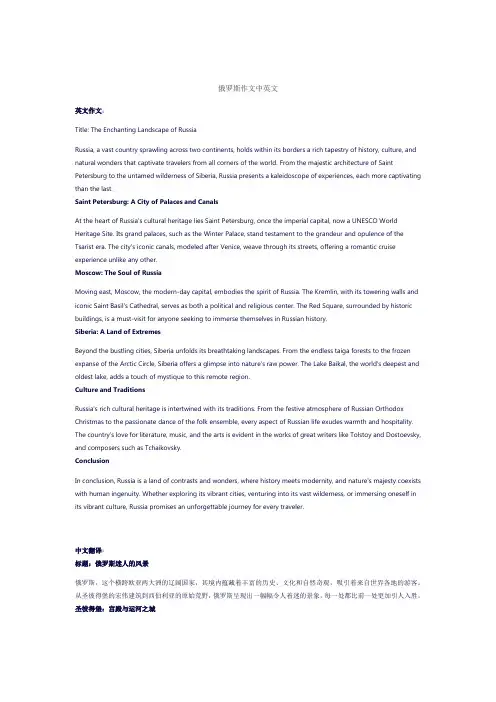
俄罗斯作文中英文英文作文:Title: The Enchanting Landscape of RussiaRussia, a vast country sprawling across two continents, holds within its borders a rich tapestry of history, culture, and natural wonders that captivate travelers from all corners of the world. From the majestic architecture of Saint Petersburg to the untamed wilderness of Siberia, Russia presents a kaleidoscope of experiences, each more captivating than the last.Saint Petersburg: A City of Palaces and CanalsAt the heart of Russia's cultural heritage lies Saint Petersburg, once the imperial capital, now a UNESCO World Heritage Site. Its grand palaces, such as the Winter Palace, stand testament to the grandeur and opulence of the Tsarist era. The city's iconic canals, modeled after Venice, weave through its streets, offering a romantic cruise experience unlike any other.Moscow: The Soul of RussiaMoving east, Moscow, the modern-day capital, embodies the spirit of Russia. The Kremlin, with its towering walls and iconic Saint Basil's Cathedral, serves as both a political and religious center. The Red Square, surrounded by historic buildings, is a must-visit for anyone seeking to immerse themselves in Russian history.Siberia: A Land of ExtremesBeyond the bustling cities, Siberia unfolds its breathtaking landscapes. From the endless taiga forests to the frozen expanse of the Arctic Circle, Siberia offers a glimpse into nature's raw power. The Lake Baikal, the world's deepest and oldest lake, adds a touch of mystique to this remote region.Culture and TraditionsRussia's rich cultural heritage is intertwined with its traditions. From the festive atmosphere of Russian Orthodox Christmas to the passionate dance of the folk ensemble, every aspect of Russian life exudes warmth and hospitality. The country's love for literature, music, and the arts is evident in the works of great writers like Tolstoy and Dostoevsky, and composers such as Tchaikovsky.ConclusionIn conclusion, Russia is a land of contrasts and wonders, where history meets modernity, and nature's majesty coexists with human ingenuity. Whether exploring its vibrant cities, venturing into its vast wilderness, or immersing oneself in its vibrant culture, Russia promises an unforgettable journey for every traveler.中文翻译:标题:俄罗斯迷人的风景俄罗斯,这个横跨欧亚两大洲的辽阔国家,其境内蕴藏着丰富的历史、文化和自然奇观,吸引着来自世界各地的游客。
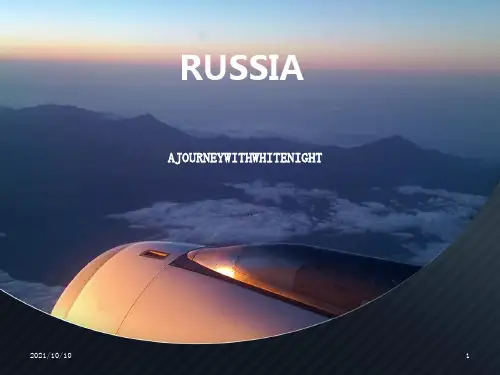
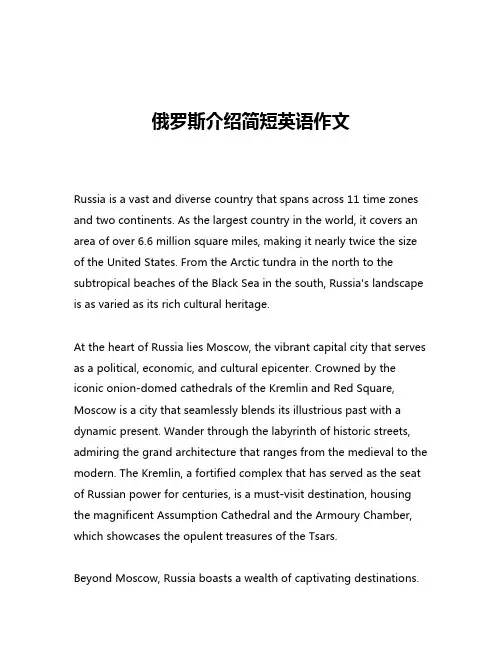
俄罗斯介绍简短英语作文Russia is a vast and diverse country that spans across 11 time zones and two continents. As the largest country in the world, it covers an area of over 6.6 million square miles, making it nearly twice the size of the United States. From the Arctic tundra in the north to the subtropical beaches of the Black Sea in the south, Russia's landscape is as varied as its rich cultural heritage.At the heart of Russia lies Moscow, the vibrant capital city that serves as a political, economic, and cultural epicenter. Crowned by the iconic onion-domed cathedrals of the Kremlin and Red Square, Moscow is a city that seamlessly blends its illustrious past with a dynamic present. Wander through the labyrinth of historic streets, admiring the grand architecture that ranges from the medieval to the modern. The Kremlin, a fortified complex that has served as the seat of Russian power for centuries, is a must-visit destination, housing the magnificent Assumption Cathedral and the Armoury Chamber, which showcases the opulent treasures of the Tsars.Beyond Moscow, Russia boasts a wealth of captivating destinations.St. Petersburg, often referred to as the "Venice of the North," is a stunning city that was built by Tsar Peter the Great in the early 18th century. Stroll along the banks of the Neva River, marveling at the pastel-hued Baroque and Neoclassical buildings that line the streets. Visit the world-famous Hermitage Museum, one of the largest art museums in the world, and admire the priceless collections of artwork, from ancient artifacts to masterpieces by the likes of Rembrandt and Michelangelo.Russia's natural beauty is equally as impressive as its man-made wonders. The vast Siberian wilderness, stretching across the eastern part of the country, is a land of untamed landscapes, from the lush taiga forests to the rugged mountains and the frozen tundra. The Kamchatka Peninsula, located on Russia's Pacific coast, is a true natural marvel, home to the iconic volcanoes of the Ring of Fire and a diverse array of wildlife, including the majestic Kamchatka brown bear.One of the most unique and captivating regions of Russia is the Baikal Lake, the world's largest and deepest freshwater lake. Situated in Siberia, this ancient lake is a true natural wonder, boasting crystal-clear waters and a diverse ecosystem that includes numerous endemic species. Visitors can explore the lake's shores, hike through the surrounding forests, and even venture out onto the ice during the winter months, when the lake transforms into a vast, frozenexpanse.Russia's cultural heritage is equally as diverse and fascinating as its geography. The country is home to a rich tapestry of traditions, from the iconic matryoshka dolls and the intricate Fabergé eggs to the captivating performances of the Bolshoi Ballet. Russian literature, music, and art have also left an indelible mark on the world, with renowned authors such as Tolstoy, Dostoevsky, and Chekhov, as well as renowned composers like Tchaikovsky and Shostakovich.Despite its reputation for harsh winters and a complex political history, Russia is a country that is brimming with warmth and hospitality. The people of Russia are known for their strong sense of national pride, their resilience, and their deep appreciation for their cultural heritage. Visitors to Russia can expect to be welcomed with open arms, and to be immersed in a world of rich traditions, stunning natural beauty, and a vibrant, dynamic culture.In conclusion, Russia is a country that defies easy categorization. It is a land of contrasts, where the old and the new coexist, and where the natural and the man-made come together in a stunning display of beauty and grandeur. Whether you are drawn to its historic cities, its awe-inspiring landscapes, or its rich cultural heritage, Russia is a destination that is sure to leave a lasting impression on all who venture there.。
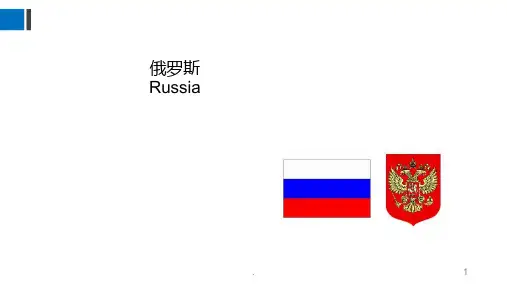
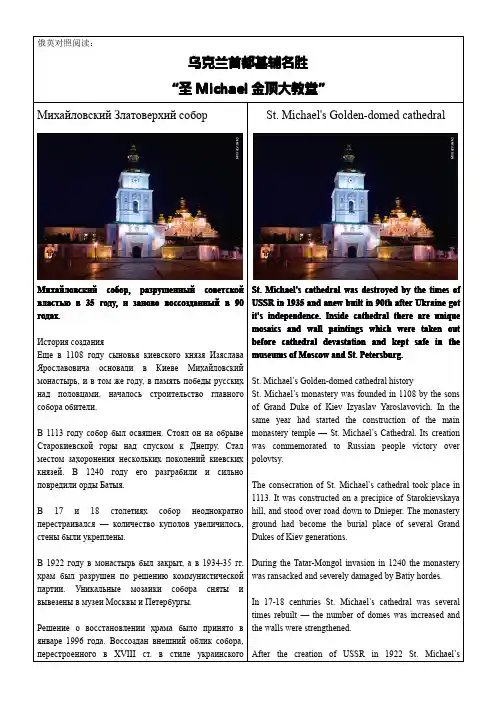
俄英对照阅读:乌克兰首都基辅名胜“圣Michael金顶大教堂金顶大教堂””МихайловскийЗлатоверхийсоборМихайловскийсоборсобор,,разрушенныйсоветскойвластьюв35годугоду,,изанововоссозданныйв90годахгодах..ИсториясозданияЕщев1108годусыновьякиевскогокнязяИзяславаЯрославовичаосноваливКиевеМихайловскиймонастырь,ивтомжегоду,впамятьпобедырусскихнадполовцами,началосьстроительствоглавногособораобители.В1113годусоборбылосвящен.СтоялоннаобрывеСтарокиевскойгорынадспускомкДнепру.Сталместомзахоронениянесколькихпоколенийкиевскихкнязей.В1240годуегоразграбилиисильноповредилиордыБатыя.В17и18столетияхсоборнеоднократноперестраивался—количествокуполовувеличилось,стеныбылиукреплены.В1922годувмонастырьбылзакрыт,ав1934-35гг.храмбылразрушенпорешениюкоммунистическойпартии.УникальныемозаикисобораснятыивывезенывмузеиМосквыиПетербургы.Решениеовосстановлениихрамабылопринятовянваре1996года.Воссозданвнешнийобликсобора,перестроенноговXVIIIст.встилеукраинскогоSt.Michael's Golden-domed cathedralSt.Michael's cathedral was destroyed by the times of USSR in1935and anew built in90th after Ukraine got it's independence.Inside cathedral there are unique mosaics and wall paintings which were taken out before cathedral devastation and kept safe in the museums of Moscow and St.Petersburg.St.Michael’s Golden-domed cathedral historySt.Michael’s monastery was founded in1108by the sons of Grand Duke of Kiev Izyaslav Yaroslavovich.In the same year had started the construction of the main monastery temple—St.Michael’s Cathedral.Its creation was commemorated to Russian people victory over polovtsy.The consecration of St.Michael’s cathedral took place in 1113.It was constructed on a precipice of Starokievskaya hill,and stood over road down to Dnieper.The monastery ground had become the burial place of several Grand Dukes of Kiev generations.During the Tatar-Mongol invasion in1240the monastery was ransacked and severely damaged by Batiy hordes.In17-18centuries St.Michael’s cathedral was several times rebuilt—the number of domes was increased and the walls were strengthened.After the creation of USSR in1922St.Michael’sбарокко.ФрескибыливозвращенывУкраину.ОформлениясобораСлавуМихайловскомусоборупринеслиегомозаикиифрески.Мозаикисобораназывают«мерцающейживописью»—онисловномаревомобволакиваливсепространствохрамасвоимтозатухающимтовспыхивающимсновойсилойсиянием,онипринадлежатработемастераАлимпия,имякоторогоещеприжизнибылоокруженолегендами.monastery was closed,and in1934-35destroyed by the decision of the Soviet communist party.Unique mosaics of St.Michael’s cathedral were taken out to the museums of Moscow and St.Petersburg.In January1996,after Ukraine became a sovereign state it was decided to rebuild St.Michael’s cathedral.Anew built cathedral looks like as it was reconstructed in XVIII century in Ukrainian baroque style.Mosaics and wall paintings were returned to Ukraine and placed in cathedral.Cathedral interiorThe St.Michael cathedral gained its renown due to mosaics and wall paintings.Cathedral’s mosaics is called «flaring painting»—they are hazing enveloping all cathedral’s space with its dying down and again flaring with new volume radiance.They belong to the creation of master Alimpiy,whose name was surrounded by legends already during his life.ФотогалереяPhoto gallery。

What is Russia - IntroductionRussia is the country of vast landscapes, interesting people. T aking a wide space of 9000 kilometers from west to east and 5000 from north to south, being home to people of so many different nationalities and customs, Russia is often called a "bridge" between Europe and Asia, both geographically and sociologically.From the ancient times up to now, Russia has been changing and re-shaping itself, its boundaries, its culture. In the ancient times, many different nations and their traditions has defined the unique Russian character and culture.Visiting Russia, especially if you come by a plane, you'll see never-ending forests and lakes.Facts about RussiaRussia is the largest country in the world. Ural mountains divide Eurasian continent - and Russia - to Europe and Asia. One fourth of Russian territory lies in Europe, the other part lies in Asia. Russia’s taking the area of 17.1 million square kilometers - it’s like USA and Europe together. The capital of Russia is Moscow and the second largest city is St. Petersburg (which is also called the "Northern capital").PopulationThe population is 147.5 million people and three fourths live in the European part and one fourth lives in the Asian part of Russia (Siberia and Far East regions). The language spoken is mostly Russian.HistoryPeter the Great believed that only through intensive contacts with Europe and European style reforms Russia can be successfully developed. He reformed government structure and system of courts. He put Orthodox Church under the state control. He obliged nobles to get education and founded national Academy of Science. Peter the Great forced the development of Russia, under his rule Russia became powerful state armed with modern institutions and technologi es.Ekaterina II (Great) - The most successful imperess of Russia, a very powerful and smart women.沙皇tsar [za:(r)]Hitler declared the war on Russia on June 22nd 1941. During the first phase of the war Germany army defeated Red Army, blocked St.Petersburg and came as close as 30km to Moscow. Red army stopped Germans only in 1943 at the Battle for Stalingrad and started its victorious reconquest of the Soviet Union and Eastern Europe which was finished on May 9th 1945. USSR lost about 25 million people in that war, it is a big contribution for the victory of Second World War, all of us should remember this.In the 1991 the country ceased to exist. Instead of USSR 15 independent states were proclaimed, Russian Federation became the largest successor of former Union.Vladimir Lenin, Iosef Stalin, Khrushchev ,Gorbachov, Vladimir Putin.Lenin, Vladimir - is the "father of Russian revolution", the first communist leader.Eltsin, Boris - the first President of the Russian Federation, who was died in April of this year. Putin, Vladimir - the second President of the Russian FederationWhy Vladimir use Lenin as his nickname?Putin—song? Smoking, drinking, family violence, three big social crisis.MoscowMoscow, capital and largest city of Russia, and the country’s leading political, cultura l, economic, and transportation center. Moscow lies on the Moscow River in the west central European part of Russia.Moscow has matured over a millennium into a richly layered, ever-expanding, and never-sleeping metropolis. Its sporadic growth has left it without a compact downtown, which means that great sights, hotels, and restaurants can be found in nearly any corner of the city. Its vast territory requires a good bit of walking and plenty of rides via metro (subway), taxi, or tour bus.Moscow has a continental climate, with long, cold winters and short, mild summers.。

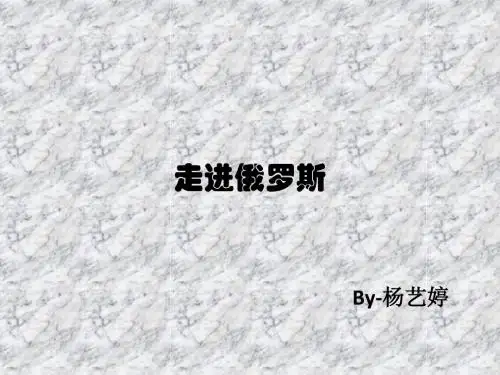
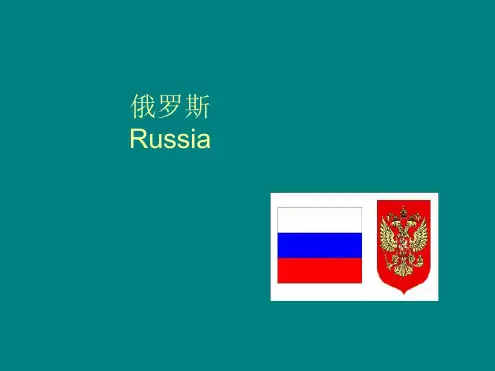
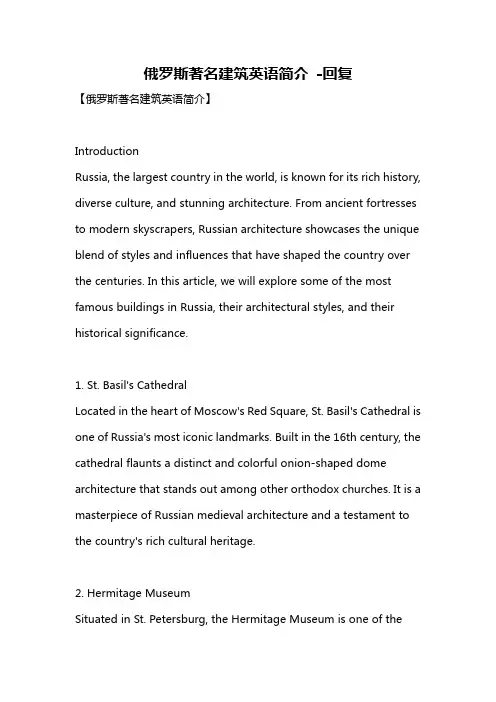
俄罗斯著名建筑英语简介-回复【俄罗斯著名建筑英语简介】IntroductionRussia, the largest country in the world, is known for its rich history, diverse culture, and stunning architecture. From ancient fortresses to modern skyscrapers, Russian architecture showcases the unique blend of styles and influences that have shaped the country over the centuries. In this article, we will explore some of the most famous buildings in Russia, their architectural styles, and their historical significance.1. St. Basil's CathedralLocated in the heart of Moscow's Red Square, St. Basil's Cathedral is one of Russia's most iconic landmarks. Built in the 16th century, the cathedral flaunts a distinct and colorful onion-shaped dome architecture that stands out among other orthodox churches. It is a masterpiece of Russian medieval architecture and a testament to the country's rich cultural heritage.2. Hermitage MuseumSituated in St. Petersburg, the Hermitage Museum is one of thelargest and oldest museums in the world. The museum complex consists of several buildings, with the Winter Palace being the most prominent. The Winter Palace, built in the Baroque style, showcases opulent interiors and houses an extensive collection of art and cultural artifacts. It is an architectural marvel that symbolizes the grandeur of the Russian emperors.3. Peter and Paul FortressBuilt in the early 18th century, the Peter and Paul Fortress is a historic complex located in St. Petersburg. The fortress served as a defensive structure and later became a political prison. Its cathedral, with a towering bell tower and golden spire, is the final resting place of many Russian emperors and empresses. The fortress, with its imposing walls and bastions, represents the founding of the city and played a significant role in Russian history.4. Bolshoi TheatreThe Bolshoi Theatre, located in Moscow, is one of the world's most renowned opera and ballet theaters. The current building, built in the neoclassical style, dates back to the 19th century. Its grandfaçade and opulent interio rs showcase the elegance of Russian classical architecture. The Bolshoi Theatre continues to hostworld-class performances and is a symbol of Russia's cultural heritage.5. Kazan CathedralFound in St. Petersburg, the Kazan Cathedral is a majestic Orthodox church dedicated to Our Lady of Kazan. Built in the early 19th century, the cathedral features a blend of Neoclassical and Russian Revival architectural styles. Its large colonnade, iconic colonnaded portico, and ornate interiors make it an impressive religious site and a popular tourist attraction.6. Moscow State UniversityAs one of the Seven Sisters (a group of neoclassical skyscrapers), Moscow State University is not only a prestigious educational institution but also a prominent architectural landmark. Built in the Stalinist Gothic style, this majestic building stands on the Sparrow Hills, offering panoramic views of Moscow. Its impressive size, ornate details, and central location make it an integral part of the city's skyline.ConclusionFrom the ancient beauty of St. Basil's Cathedral to the grandeur ofthe Hermitage Museum, Russian architecture captures the essence of the country's history, culture, and artistic achievements. These iconic buildings stand as a testament to the skill and creativity of Russian architects throughout the centuries. Whether you visit Russia or admire its architecture from afar, these landmarks will continue to inspire awe and appreciation for years to come.。

各个国家中英文介绍1 非洲Africa撒哈拉沙漠the Sahara Desert 苏伊士运河the Suez Canal 金字塔pyramid 狮身人面像Sphinx印度洋Indian Ocean 大西洋Atlantic Ocean地中海the mediterranean sea 刚果河Congo River尼罗河the Nile2 美洲America太平洋Pacific Ocean 拉丁美洲Latin America Greenland 北冰洋the Arctic Ocean格陵兰岛墨西哥湾the Gulf of Mexico 加勒比海Caribbean Sea 巴拿马运河Panama Canal3 亚洲Asia泰姬陵Taj Mahal 珠穆朗玛峰Mount Qomolangma 喜马拉雅山the Himalayas 青藏高原tibetan plateau道教Taoism 佛教Buddhism基督教Christianity 伊斯兰教IslamEurope 4 欧洲Alps 阿尔卑斯山Eiffel Tower 埃菲尔铁塔欧洲各国国名及首都对照表国名首都Western Europe(7):Paris巴黎法国France都柏林Ireland Dublin 爱尔兰阿姆斯特丹荷兰Netherlands Amsterdam Brussels Belgium 比利时布鲁塞尔卢森堡卢森堡Luxembourg Luxembourg伦敦United Kingdom London 英国摩纳哥摩纳哥MonacoMonaco-villeCentral Europe(9):波兰Poland 华沙Warsaw伯尔尼Switzerland 瑞士Bern瓦杜兹Liechtenstein Vaduz 列支敦士登维也纳奥地利Austria Vienna布达佩斯匈牙利Hungary Budapest布拉格Czech 捷克Prague布拉提斯拉发Bratislava 斯洛伐克Slovakia柏林Germany 德国Berlin卢布尔雅那Slovenia斯洛文尼亚LjubljanaSouthern Europe(17):葡萄牙Portugal 里斯本Lisbon马德里西班牙Spain Madrid安道尔Andorra 安道尔Andorra la VellaGreece Athens雅典希腊意大利Italy 罗马Rome圣马力诺圣马力诺San Marino San Marino斯科普里Malta Skopje 马耳他梵蒂冈梵蒂冈Vatican V atican索非亚Bulgaria 保加利亚Sofia布加勒斯特Bucharest 罗马尼亚Romania贝尔格莱德Serbia Belgrade 塞尔维亚萨格勒布Zagreb Croatia克罗地亚萨拉热窝波斯尼亚和黑塞哥维那Bosnia and Herzegovina Sarajevo 波德戈里察Montenegro Podgorica 黑山地拉那阿尔巴尼亚Albania Tirana 斯科普里MacedoniaSkopje马其顿Northern Europe(5):丹麦Denmark 哥本哈根Copenhagen奥斯陆挪威Norway Oslo雷克雅未克Reykjavik Iceland 冰岛赫尔辛基Finland Helsinki 芬兰斯德哥尔摩SwedenStockholm瑞典Eastern Europe(7):乌克兰Ukraine 基辅kyiv莫斯科俄罗斯Russia Moscow明斯克Minsk Belarus 白俄罗斯维尔纽斯Lithuania Vilnius 立陶宛里加Riga Latvia 拉脱维亚塔林爱沙尼亚Estonia Tallinn基希纳乌摩尔多瓦ChisinauMoldova5 大洋洲Oceania。
俄罗斯中英双语介绍The national symbol is the brown bear. The national drink is vodka. Local tennis star AnnaKournikova is a global ginup. But what else do you know about Russia?这个国家的象征是棕熊,国酒是伏特加,本土网球明星安娜库尔尼科娃的海报遍及全球。
但除此以外,你还对俄罗斯有其它的了解吗?GeographyRussia takes up one eighth of the world's land mass. It lies on two continents, Europe and Asia. It is the world's largest country with a bout 17 million square kilometres.地理俄罗斯占世界陆地面积的1/8,地跨欧亚两大陆。
它的面积约有1700万平方公里,是世界上领土最大的国家。
Onion DomesMoscow postcards typically feature the colourful striped domes of St . Basil's Cathedral and theneighboring Red Square. St. Basil's was b uilt between 1555 and 1561. Other Russian churchesalso have flam e-shaped domes. The dome's peak is said to be like the flame of pra yer reaching up toward heaven. The cross at the top symbolizes Chri st.洋葱型屋顶典型的莫斯科明信片上的风光图就是圣瓦西里大教堂彩色条纹圆屋顶和相邻的红场。
Russia is the biggest country on Earth. In all, about 141 million people live in Russia.The weather tends to be cold, with long winters and short summers.A great plain stretches over European Russia. Slow-moving rivers crisscross this plain, including the Volga, the Daugava, and the Don. Most Russians live in this part of the country.In the north, many swamps and lakes dot the plain. In the south, the rich soils make good farmland.The capital of Russia is MoscowAt the heart of Moscow is a famous old fortress called the Kremlin. Today, the Kremlin is the seat of the Russian government. At the foot of the Kremlin’s eastern walls is Red Square, a vast public square that has been the scene of many famous events in Russian history. On the south end of Red Square is Saint Basil’s Cathedral.The next largest city is Saint Petersburg, Russia’s biggest seaport. Its lavish palaces and grand cathedrals make it one of Europe’s most beautiful cities. Russia's most exquisite instrument, pay attention to clothing. Folk in Russia, married women have to wear headscarves, and given priority to with white; Unmarried girls do not wear headscarves, but often wear a hat.On the diet, the russians pay attention to large amount of material benefit, big taste thick oil. Their food in some production is relatively coarse.Russians are the most preferred "7", think it is a success, a good omen. For "13" and "Friday", they are very dirty.The russians worship salt and horses very much.Russian claims "left a prime, right main ji", therefore, they are not allowed to left hand contact with others, or to the delivery of goods.Russia's holiday a lot, let me simple introduce next holiday. After the New Year, Spring Festival is the second most popular holiday. Yesterday is one of the four seasons festivals, people to celebrate after a long winter, bright sun began to bring the earth warm. During the festival to eat rye baked plough, rake form big bread. Thank the meat section for 7 days, each have its name, every day celebration is not the same.俄罗斯是最大的国家在地球上。
介绍俄罗斯英文的课件介绍俄罗斯英文的课件俄罗斯联邦(俄语:Российская Федерация,英语:The Russian Federation),通称俄罗斯或俄国(Russia),是由22个自治共和国、46个州、9个边疆区、4个自治区、1个自治州、3个联邦直辖市组成的联邦共和立宪制国家。
那么,你知道俄罗斯的英语单词怎么说吗?下面是小编为你带来的介绍俄罗斯英文课件,欢迎阅读。
俄罗斯的英文释义:Russia俄罗斯的英文例句:俄罗斯是被包藏在一个闷胡芦里面的神秘物体之中的谜。
Russia is a riddle wrapped in a mystery inside an enigma.俄罗斯周四加入五个西方主要国家的行列,同声呼吁南斯拉夫尊重民主规范,并警告贝尔格勒当局不要在塞尔维亚及蒙地内哥罗境内进行政治迫害。
Russia joined five leading Western powers on Thursday in calling on Yugoslavia to respect democratic norms and warning Belgrade to refrain from political violence in Serbia or against Montenegro.中国、俄罗斯和美国都知道它们在世界事务中所起的作用。
China, Russia and the United States are aware of the role they play in world affairs.俄罗斯说,它认为这一系统会妨碍俄罗斯的核威慑力量。
Russia says it believes the system could blunt its own nuclear deterrent.俄罗斯的英文单词有关方面已邀请俄罗斯参与,但俄罗斯尚未涉入这一项目。
Russia has been invited to join the project but has yet to do so.普金最不看重的格鲁吉亚已被迫接受了俄罗斯天然气的价格,这个价格要比给白俄罗斯的最新价格高出2倍多。
俄罗斯联邦(俄语:РоссийскаяФедерация英语:Russian Federation),简称俄罗斯、俄国或砬垿。
公元9世纪,在建立以基辅为中心的古罗斯国家过程中,逐步形成了俄罗斯人的祖先古罗斯部族人(东斯拉夫人),并成为此后国家名称。
作为前苏联的主要加盟共和国,俄罗斯联邦具有相当的全球影响力。
1991年,苏联解体,俄罗斯继承苏联成为联合国安全理事会五大常任理事国,对安理会议案拥有否决权。
俄罗斯是世界上面积最大的国家,亦是世界第二军事强国,已成为全球最大的天然气出口国及OPEC以外最大的原油输出国。
2014年3月17日,俄罗斯承认克里米亚共和国为独立的主权国家。
2014年3月18日,批准克里米亚加入俄罗斯的国家间协议草案。
33俄罗斯联邦,简称俄罗斯或俄联邦,是世界上领土面积最大的国家,地域跨越欧亚两个大洲,绵延的海岸线从北冰洋一直伸展到北太平洋,还包括了内陆海黑海和里海。
与中国、蒙古、朝鲜等国接壤,同时,俄罗斯还与日本、美国、加拿大等国隔海相望。
为前苏联的主要加盟共和国,1991年,苏联解体,俄罗斯继承苏联成为联合国安全理事会常任理事国,对安理会议案拥有否决权。
俄罗斯是仅次于美国的世界第二军事强国,亦为在世界范围内拥有巨大影响力的世界强国,也是G8成员国之一。
俄罗斯现为全球最大的天然气出口国及OPEC以外最大的原油输出国。
史上最全俄罗斯中英双语介绍、HistoryFormerly the dominant republic of the Union of Soviet Socialist Republics (USSR), Russia is now an independent country, and an influential member of the Commonwealth of Independent States, since the union’s dissolution in December 1991. During the Soviet era, Russia was officially called the Russian Soviet Federated Socialist Republic (RSFSR). Russia is usually considered the Soviet Union’s successor state in diplomatic matters.Russia was founded in the 12th century as the Principality of Muscovy. It was able to emerge from over 200 years of Mongol domination (13th-15th centuries) and to gradually conquer and absorb surrounding principalities. In the early 17th century, a new Romanov Dynasty continued this policy of expansion across Siberia to the Pacific. Under Peter I (ruled 1682-1725), hegemony was extended to the Baltic Sea and the country was renamed the Russian Empire. During the 19th century, more territorial acquisitions were made in Europe and Asia. Repeated devastating defeats of the Russian army in World War I led to widespread rioting in the major cities of the Russian Empire and to the overthrow in 1917 of the imperial household.The Communists under Vladimir Lenin seized power soon after and formed the USSR. Josef Stalin (1928-53) strengthened Russian dominance of the Soviet Union.The Soviet Union consolidated its hold on Eastern Europe and sought to expand its influence elsewhere in the world. This active foreign policy helped bring about the Cold War, which turned the Soviet Union’s wartime allies, the United Kingdom and the United States, into foes.Stalin died in 1953 and in the absence of an acceptable successor, the Soviet economy and society stagnated in the following decades until General Secretary Mikhail Gorbachev (1985-91) introduced glasnost (openness) and perestroika (restructuring) in an attempt to modernize Communism. However, his initiatives inadvertently released forces that by December 1991 splintered the USSR into 15 independent republics. Since then, Russia has struggled in its efforts to build a democratic political system and market economy to replace the strict social, political, and economic controls of the Communist period.Most of the area, population, and industrial production of the Soviet Union, then one of the world’s two superpowers, lay in Russia. After the breakup of the USSR, Russia’s global role however has greatly diminished, and cannot be compared to that of the former Soviet Union.历史俄罗斯是前苏联社会主义共和国的主要国家,现在是一个独立国家,自从1991年苏联解体后它是独立的联邦政府中最有影响的成员。
在苏联时期,俄罗斯正式的名称叫做俄罗斯苏联同盟社会主义共和国。
俄罗斯在外交事宜中通常被看作是苏联的继承者。
俄罗斯作为俄国公国在12世纪建立的。
它开始脱离蒙古(13到15世纪)200多年的统治,并且逐渐征服周围的公国。
在17世纪早期,新的罗马诺王朝继续从西伯利亚往太平洋扩张。
在彼得一世(统治从1682至1725)的率领下,国土延伸至波罗的海并将国家命名为俄罗斯帝国。
在19世纪,从欧洲和亚洲获得了更大的领土。
在第一次世界大战中俄军的节节败退导致了国内主要城市的大暴动,在1917年推翻了沙皇的统治。
共产党在列宁的领导下夺取了军权,随后建立了苏联。
斯大林(1928-53)巩固了俄罗斯人在苏联的统治。
苏联加强了它在东欧的实力,并在全世界寻求扩大影响。
这种活跃的外交政策导致了冷战,它使苏联战时的同盟-英国和美国陷入敌对状态。
1953年斯大林的逝世,而国家又缺少合适的继承者,这使得随后的几十年里苏联经济和社会变得萧条,直到秘书长戈尔巴乔夫(1985-91)提出在尝试现代化共产主义中公开化(开放)和改革(重组)。
然而他的积极政策客观上使苏联在1991年12月分裂为15个独立的共和国。
从那时起,俄罗斯开始努力建设民主政治体制并以市场经济来取代共产党时期的计划经济。
前苏联大部分的地区,人口和工业生产在俄罗斯,使之成为世界两大超级大国之一。
但苏联解体之后,俄罗斯的国际地位大大降低,已经无法与前苏联相比。
GeographyThe Russian Federation or Russia is a country that stretches over a vast expanse of Europe and Asia. With an area of some 17,075,200 km²(6,595,600 mi²), it is the largest country in the world, covering almost twice the territory of the next-largest country, Canada. It ranks eighth in the world in population. It shares land borders with the following countries: Norway, Finland, Estonia, Latvia, Lithuania, Poland (only through Kaliningrad Oblast), Belarus, Ukraine, Georgia, Azerbaijan, Kazakhstan, China, Mongolia and North Korea.Russia stretches across much of the north of the supercontinent of Eurasia. Itcontains a large share of the world’s Arctic and sub-Arctic areas, and therefore has less population, economic activity, and physical variety per unit area than most countries, the great area south of these still accommodates a great variety of landscapes and climates. Most of the land consists of vast plains, both in the European part and the Asian part that is largely known as Siberia. These plains are predominantly steppe to the south and heavily forested to the north, with tundra along the northern coast. Mountain ranges are found along the southern borders, such as the Caucasus (containing Mount Elbrus, Russia’s and Europe’s highest point at 5,633m) and the Altai, and in the eastern parts, such as the Verkhoyansk Range or the volcanoes on Kamchatka. The more central Ural Mountains is a north-south range which divides Europe from Asia.Russia has an extensive coastline of over 37,000km along the Arctic and Pacific Oceans, as well as more or less inland seas such as the Baltic, Black and Caspian seas. Some smaller bodies of water are part of the open oceans; the Barents Sea, White Sea, Kara Sea, Laptev Sea and East Siberian Sea are part of the Arctic, whereas the Bering Sea, Sea of Okhotsk and the Sea of Japan belong to the Pacific Ocean. Major islands found in them include Novaya Zemlya, the Franz-Josef Land, the New Siberian Islands, Wrangel Island, the Kuril Islands and Sakhalin地理俄罗斯是一个跨越欧亚两大洲的国家。